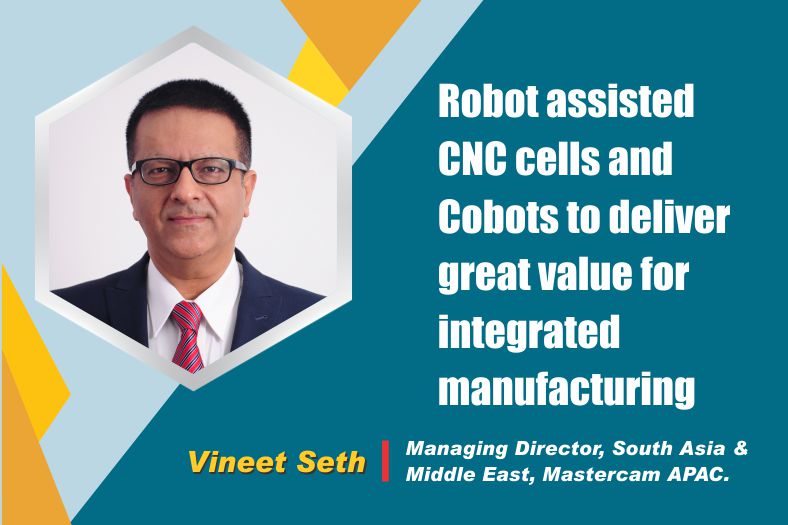Robot assisted CNC cells and Cobots to deliver great value for integrated manufacturing
By OEM Update Editorial February 1, 2022 4:55 pm IST
Industrial robots are already adding great value to manufacturing and their capability as well as reliability is increasing day by day.
What are the upcoming technology trends in metal forming/ metal cutting?
The hybrid manufacturing process that combines Additive Manufacturing (AM) and Subtractive Manufacturing (SM) is really the most talked about technology in our markets. As I have spoken quite a bit in the past few years, the footprint of the new-age machine is critical to manufacturing success of any organisation, considering that real estate cost per machine is going up quite a lot in recent times. Being able to process a component in a single station or as few as possible, is the new productivity mantra across industries.
Bringing AI into manufacturing, the ability to measure various processes parameters and provide intelligent reports in real-time, while harnessing big data – is also another technology that is seeing fast adoption.
Please talk about the innovations like digitalization, robotics and AI impacting the performance of metal forming and cutting processes.
Digitisation or Digitalisation as it is sometimes called is an evolving science. The potential this field holds is virtually unlimited! There are numerous innovations that are happening in the areas of mapping material and tool characteristics, machine tool kinematics, toolpath motions and also, with increasing compatibility across online and offline systems, since there are no global standards that are defined for this technology.
AI is an integral part of digitisation, as access to real-time data in conjunction with Knowledge based machining systems, allows for analytics as well as decision making systems regarding areas such as tool life, refining toolpath strategies, monitoring operator and machine tool performance, as also to troubleshoot or prevent specific issues during machining.
Robotic automation plays a vital role in manufacturing. Robot assisted CNC cells as well as Co-bots deliver a great value when it comes to integrated manufacturing. Offline programming and control of such cells ensure superior quality in terms of repeatability and setup accuracies. It also solves the problem of errors due to human fatigue as well as manual programming. While enabling lights out manufacturing, it also combines in process inspection and validation, thereby ensuring a water tight production/manufacturing process – avoiding potential post-manufacturing rejections.
Robotic automation is absolutely essential, while manufacturing or repairing nuclear or hazardous material.
No doubt, Industrial robots are already adding great value to manufacturing and their capability as well as reliability is increasing day by day.
How do you see the impact of the worldwide energy challenge in Indian Manufacturing?In comparison with the top manufacturing countries of the world, India’s per capita energy consumption is the lowest. This statistic not only includes electricity, but also heating, air conditioning as well as fuel. A number of large manufacturing industries have invested in alternative sources of energy; however, there is still room to increase the percentage of alternative energy sources to traditional sources. Also, this is a broader topic for discussion on how our manufacturing ecosystem can benefit further by adopting best manufacturing practises that avoid wastage of fuel, electricity and HVAC.
Will the updated machine tools technologies bring benefits to SME and MSME sectors?
Historically, machine tool innovations and updates have almost always benefited the industry. A large beneficiary of these innovations are the SME and MSME sectors, as they are typically involved in discrete manufacturing – where this innovation and update is arguably the highest. Further, since their scalability and agility is much higher (in terms of YoY growth), the return on investment on newer machine tools and capital goods tend to be higher too. As smaller companies grow, they tend to invest in better machine tools than they started with, and this sentiment is largely due to the fact that these MSMEs are pursuing better accuracy, better functionality and better timings for their portfolio of products and services.
On the other hand, demands from OEMs on quicker turn-around times, higher quality and mass customisation needs are also factors that help MSMEs make the decision to invest in newer and updated machine tools & technologies.
How do you evaluate the demand for enhancing machining processes?
However, on the topic of evaluating the demand for enhancing machining processes from the CAM development perspective, we have a worldwide network of partners, resellers and customer users who tell us what is important for them. These enhancements make their way through a few funnels to filter them and classify them into common pools first. Based on criticality and priority these enhancements are then listed to find their way into future releases of our software.
In addition to the above, we are constantly working with OEMs of machine tools, cutting tools, work holding devices, materials, coolants and IIoT systems, to introduce futuristic technologies and compatibility processes into the software on a parallel and continual basis.
What new trends are impacting machine tools?
Some of the biggest impacts in recent times to machine tools have been in the area of form factor, controller technology – which includes added functionality to work with IIoT systems, Multi-tasking functionality in terms of kinematics and ease of operation/automation.
The need for real-time data, flexibility in manufacturing schedules and lights out machining, among others are primary motivators for the Machine Tools smart manufacturing markets.
Cookie Consent
We use cookies to personalize your experience. By continuing to visit this website you agree to our Terms & Conditions, Privacy Policy and Cookie Policy.


















